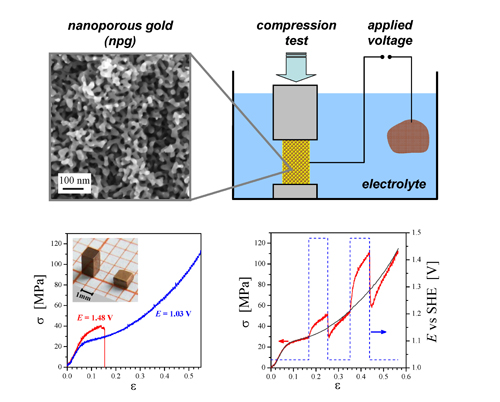In cooperation with German scientist from Technical University of Hamburg, Researcher from Shenyang National laboratory for Materials Science has created a new “hybrid” material which is capable of altering its strength and brittleness, quickly and “reversibly”, in respond to an electric signal. The new material design concept allows the user to select, for instance, a soft and ductile state for processing and a high-strength state for service as a structural material.
The “hybrid” material is a solid-liquid two phase composite, formed by infiltrating nanoporous gold with an electrolyte solution. By changing the electrode potential of the nanoporous gold skeleton and thus the electrochemistry on gold/electrolyte interface, the material can be switched back and forth, and repeatedly, between “strong and brittle” and “soft and ductile” states. The flow stress can be increased by as much as a factor of 2.
The “reversible” changes of strength and brittleness can be linked to the changes on the gold surface state, i.e., the surface charge density variation and the adsorption and desorption of monolayer thick oxygen. The underlying mechanism is not fully understood. Pinning of dislocations on gold surface by the oxide may have led to the decrease of dislocation mobility and thus the increase of material strength.
This work was published in the June 3 issue of Science [DOI: 10.1126/science.1202190].

Figures: (A) Schematic illustration of compression of bulk npg samples in situ with electrochemical control. SEM image shows the uniform and small structure size (L = 20 nm) of nanoporous gold. (B) Compressive stress-strain curves measured in situ at constant potentials. Potential is specified versus the standard hydrogen electrode, SHE. Ligament surface is covered with submonolayer-thick oxygen when E = 1.48 V and is clean when potential is held at 1.03 V. The inset is a photograph of npg samples with clean surface before and after compression. (C) Responses of plastic flow (red) to potential jumps. Data obtained at a constant potential of 1.03 V (gray) were plotted for comparison.